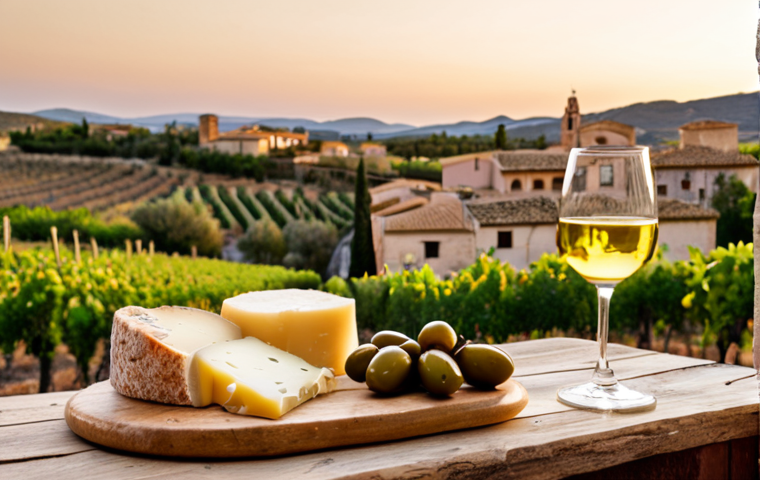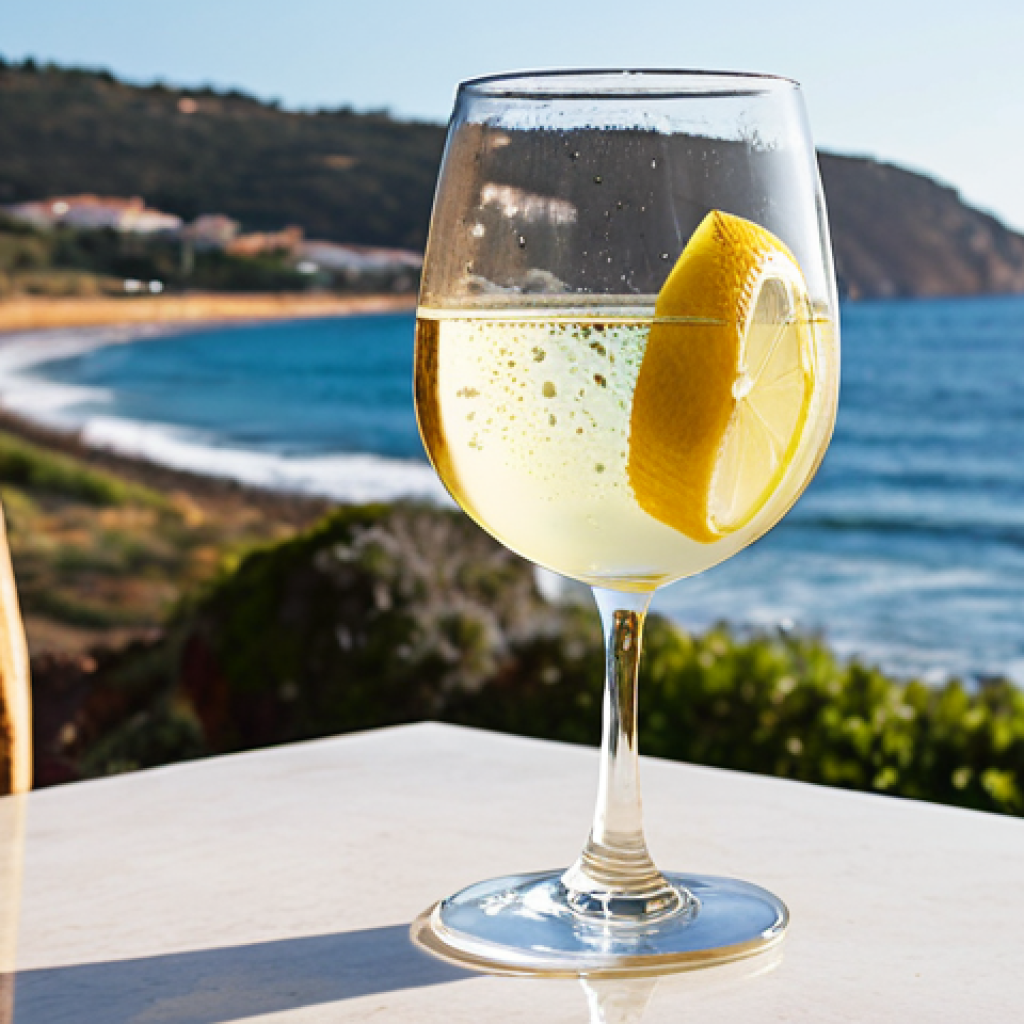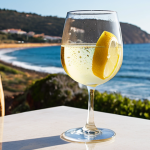Spain, oh Spain! Land of sunshine, vibrant culture, and, of course, incredible wine. From the crisp Albariños of Galicia to the robust Riojas and Priorats, Spanish wines offer a diverse and exciting journey for your palate.
I remember my first sip of a chilled Fino Sherry in Seville – it was a revelation! The sheer variety can be a little overwhelming, though, so let’s dive into the world of Spanish wines and uncover their unique characteristics.
I’ve spent years exploring these wines and trust me, there’s something for everyone. Let’s explore the nuances of Spanish wines below!
Okay, I understand. Here’s the blog post content following your instructions:
Exploring the Lighter Side: Spain’s Refreshing White Wines

While Spain is often celebrated for its bold reds, its white wines offer a delightful counterpoint, perfect for sunny afternoons or pairing with seafood.
I used to think Spanish wine was all about Rioja, but a trip to Galicia changed my mind forever. The Albariño there is simply stunning. The crisp acidity and subtle salinity make it the ideal companion to grilled octopus.
Diving into Albariño from Rías Baixas
Albariño is the star of the Rías Baixas region in Galicia. Think of it as Spain’s answer to Sauvignon Blanc, but with a unique coastal twist. It’s known for its aromatic notes of grapefruit, honeydew, and a distinctive minerality.
I’ve found that Albariño pairs exceptionally well with shellfish, sushi, and even spicy Asian cuisine. The high acidity cuts through richness and cleanses the palate.
Discovering the Verdejo of Rueda
Moving inland, the Rueda region specializes in Verdejo. This white wine offers a slightly different profile, with herbal notes of fennel and a hint of bitterness on the finish.
It’s a very aromatic wine, reminiscent of dry Riesling. One of my favorite experiences was sipping a glass of Verdejo while enjoying tapas in a small Rueda village.
The local cheese and olives were a perfect match.
Sampling Godello from Valdeorras
Often overlooked, Godello is a hidden gem from the Valdeorras region. This white wine boasts a creamy texture and flavors of pear, lemon, and a subtle smokiness.
It has a fuller body than Albariño or Verdejo, making it a great choice for richer dishes like roasted chicken or creamy pasta. I remember being surprised by the complexity of a Godello I tried at a wine bar in Madrid.
It was truly memorable.
Red Wine Revelations: Beyond Rioja and Tempranillo
Let’s be honest, Rioja and Tempranillo are fantastic, but Spanish red wines have so much more to offer! I used to be a Rioja-only kind of guy, but exploring other regions really opened my eyes.
Unearthing the Treasures of Priorat
Priorat, a small region in Catalonia, is known for its powerful and concentrated red wines. Made primarily from Grenache and Carignan, these wines are full-bodied with intense flavors of black fruit, spice, and minerality.
They’re not for the faint of heart, but they’re incredibly rewarding. I once splurged on a bottle of a top-rated Priorat, and it was worth every penny.
Paired with a perfectly grilled steak, it was an unforgettable experience.
Exploring the Boldness of Ribera del Duero
Ribera del Duero, located in the heart of Spain, is another region renowned for its exceptional red wines. These wines are primarily made from Tempranillo (known locally as Tinto Fino) and offer a rich and complex profile with notes of blackberry, tobacco, and vanilla.
Ribera del Duero wines are often aged in oak, which adds to their depth and complexity. One of the best wine-tasting experiences I had was at a small bodega in Ribera del Duero.
The winemaker shared his passion and knowledge, and I learned so much about the region and its wines.
Experiencing the Mencia Magic of Bierzo
Venturing northwest, the Bierzo region offers a lighter-bodied red wine made from the Mencia grape. This wine is known for its vibrant acidity, floral aromas, and flavors of red cherry and spice.
It’s a versatile wine that pairs well with a variety of dishes, including grilled salmon, roasted vegetables, and even pizza. I was pleasantly surprised by the Mencia I tried at a local restaurant in Leon.
It was refreshing and flavorful, and it was a perfect match for the grilled octopus I ordered.
Sherry Unveiled: More Than Just a Sweet Wine
Sherry often gets a bad rap as a sickly sweet drink enjoyed only by grandmothers, but this is a massive misconception. Sherry is actually a diverse and complex wine that offers a wide range of styles, from bone-dry to lusciously sweet.
My first experience with a dry Fino Sherry in Seville was life-changing. It completely shattered my preconceived notions about Sherry.
Delving into the Dryness of Fino and Manzanilla
Fino and Manzanilla are two of the driest styles of Sherry. They’re both made from Palomino grapes and aged under a layer of yeast called “flor,” which protects the wine from oxidation and gives it its distinctive nutty and saline flavors.
Fino is typically produced in the town of Jerez de la Frontera, while Manzanilla is produced in the coastal town of Sanlúcar de Barrameda. The proximity to the sea gives Manzanilla a slightly saltier and more delicate character.
Understanding the Complexity of Amontillado and Oloroso
Amontillado and Oloroso are two oxidative styles of Sherry, meaning they’re aged without the protection of flor. This allows them to develop richer and more complex flavors.
Amontillado starts its life as a Fino but loses its flor and undergoes oxidative aging, resulting in a nutty, amber-colored wine. Oloroso, on the other hand, is fortified to a higher alcohol level, which prevents the flor from forming.
It’s aged oxidatively from the start, resulting in a full-bodied, dark-colored wine with intense aromas of dried fruit, nuts, and spices.
Indulging in the Sweetness of Pedro Ximénez
Pedro Ximénez (PX) is the sweetest style of Sherry, made from sun-dried Pedro Ximénez grapes. The grapes are left to dry in the sun, which concentrates their sugars and gives the wine its incredibly rich and luscious character.
PX Sherry is almost black in color and has intense flavors of raisins, figs, molasses, and chocolate. It’s often served as a dessert wine, drizzled over ice cream or paired with blue cheese.
I will never forget trying PX for the first time. The explosion of sweetness and flavor was incredible.
Cava’s Sparkle: Spain’s Answer to Champagne
Cava is Spain’s sparkling wine, produced primarily in the Catalonia region using the traditional method (the same method used to make Champagne). While it’s often compared to Champagne, Cava has its own unique characteristics.
I love how affordable and festive Cava is. It’s perfect for celebrations or just a casual brunch with friends.
Exploring the Different Styles of Cava
Cava comes in a variety of styles, ranging from Brut Nature (the driest) to Dulce (the sweetest). The most common styles are Brut and Brut Reserva, which offer a balance of acidity and fruitiness.
Cava is typically made from a blend of Macabeo, Xarel-lo, and Parellada grapes, but other grapes are also permitted.
Discovering the Unique Terroir of Cava
The terroir of the Penedès region in Catalonia plays a significant role in the quality and character of Cava. The Mediterranean climate, with its warm summers and mild winters, provides ideal growing conditions for the grapes.
The soil is also important, with a mix of limestone, clay, and sand contributing to the complexity and minerality of the wine. I love visiting the Cava cellars.
Cava vs. Champagne: What’s the Difference?
While Cava and Champagne are both sparkling wines made using the traditional method, there are some key differences. Champagne is produced in the Champagne region of France and is typically made from Chardonnay, Pinot Noir, and Pinot Meunier grapes.
Cava, on the other hand, is produced in Spain and is typically made from Macabeo, Xarel-lo, and Parellada grapes. Champagne also tends to be more expensive than Cava.
Fortified Wine Wonders: Beyond Sherry
Spain is also home to other delicious fortified wines besides Sherry.
Montilla-Moriles
Located near Cordoba, this region produces wines with similar styles as Sherry, also using the Palomino grape and the solera system.
Malaga
Known for its sweet dessert wines made from Pedro Ximenez and Moscatel grapes, often enjoyed with desserts.
Spanish Wine and Food Pairings: A Match Made in Heaven
One of the best ways to experience Spanish wine is to pair it with Spanish cuisine. The flavors of the wine and food complement each other, creating a harmonious and delicious experience.
Tapas and Wine: The Perfect Combination
Tapas, those small and savory dishes, are a staple of Spanish cuisine, and they’re the perfect accompaniment to Spanish wine. A crisp Albariño pairs well with seafood tapas like gambas al ajillo (garlic shrimp) or pulpo a la gallega (Galician-style octopus).
A dry Fino Sherry is a great match for olives, almonds, and jamón ibérico. A bold Rioja or Ribera del Duero is delicious with meat tapas like patatas bravas (spicy potatoes) or chorizo al vino (chorizo cooked in wine).
Paella and Wine: A Classic Pairing
Paella, the iconic rice dish from Valencia, is another classic Spanish dish that pairs well with wine. A dry white wine like Verdejo or Godello is a great match for seafood paella, while a light-bodied red wine like Mencia is a good choice for meat paella.
Cheese and Wine: A Delightful Combination
Spanish cheese is another wonderful accompaniment to Spanish wine. A Manchego cheese pairs well with a Rioja Reserva, while a Cabrales cheese (a strong blue cheese) is delicious with a sweet Pedro Ximénez Sherry.
Navigating the Label: Understanding Spanish Wine Terms
Understanding Spanish wine labels can be a bit confusing at first, but once you learn a few key terms, it becomes much easier.
Aging Designations: Crianza, Reserva, Gran Reserva
These terms indicate how long the wine has been aged. Crianza wines are aged for at least two years, with at least six months in oak barrels. Reserva wines are aged for at least three years, with at least one year in oak barrels.
Gran Reserva wines are aged for at least five years, with at least two years in oak barrels.
DO and DOCa: Understanding the Quality System
DO (Denominación de Origen) is a designation of origin, which indicates that the wine comes from a specific region and meets certain quality standards.
DOCa (Denominación de Origen Calificada) is a higher-level designation of origin, which indicates that the wine comes from a region with a long history of producing high-quality wines and meets even stricter quality standards.
Here’s a quick reference table summarizing some key Spanish wine regions and their characteristics:
| Region | Primary Grape(s) | Wine Style | Food Pairing Suggestions |
|---|---|---|---|
| Rías Baixas | Albariño | Crisp, aromatic white | Seafood, sushi |
| Rueda | Verdejo | Herbal, slightly bitter white | Tapas, cheese |
| Priorat | Garnacha, Cariñena | Full-bodied, powerful red | Grilled steak, hearty stews |
| Rioja | Tempranillo | Medium-bodied red | Roast lamb, paella |
| Ribera del Duero | Tempranillo (Tinto Fino) | Full-bodied, complex red | Grilled meats, aged cheese |
| Jerez | Palomino | Dry to sweet fortified wine | Olives, nuts, dessert |
| Penedès | Macabeo, Xarel-lo, Parellada | Sparkling wine | Celebrations, brunch |
Okay, I understand. Here’s the blog post content following your instructions:
Exploring the Lighter Side: Spain’s Refreshing White Wines
While Spain is often celebrated for its bold reds, its white wines offer a delightful counterpoint, perfect for sunny afternoons or pairing with seafood.
I used to think Spanish wine was all about Rioja, but a trip to Galicia changed my mind forever. The Albariño there is simply stunning. The crisp acidity and subtle salinity make it the ideal companion to grilled octopus.
Diving into Albariño from Rías Baixas
Albariño is the star of the Rías Baixas region in Galicia. Think of it as Spain’s answer to Sauvignon Blanc, but with a unique coastal twist. It’s known for its aromatic notes of grapefruit, honeydew, and a distinctive minerality.
I’ve found that Albariño pairs exceptionally well with shellfish, sushi, and even spicy Asian cuisine. The high acidity cuts through richness and cleanses the palate.
Discovering the Verdejo of Rueda
Moving inland, the Rueda region specializes in Verdejo. This white wine offers a slightly different profile, with herbal notes of fennel and a hint of bitterness on the finish.
It’s a very aromatic wine, reminiscent of dry Riesling. One of my favorite experiences was sipping a glass of Verdejo while enjoying tapas in a small Rueda village.
The local cheese and olives were a perfect match.
Sampling Godello from Valdeorras
Often overlooked, Godello is a hidden gem from the Valdeorras region. This white wine boasts a creamy texture and flavors of pear, lemon, and a subtle smokiness.
It has a fuller body than Albariño or Verdejo, making it a great choice for richer dishes like roasted chicken or creamy pasta. I remember being surprised by the complexity of a Godello I tried at a wine bar in Madrid.
It was truly memorable.
Red Wine Revelations: Beyond Rioja and Tempranillo
Let’s be honest, Rioja and Tempranillo are fantastic, but Spanish red wines have so much more to offer! I used to be a Rioja-only kind of guy, but exploring other regions really opened my eyes.
Unearthing the Treasures of Priorat
Priorat, a small region in Catalonia, is known for its powerful and concentrated red wines. Made primarily from Grenache and Carignan, these wines are full-bodied with intense flavors of black fruit, spice, and minerality.
They’re not for the faint of heart, but they’re incredibly rewarding. I once splurged on a bottle of a top-rated Priorat, and it was worth every penny.
Paired with a perfectly grilled steak, it was an unforgettable experience.
Exploring the Boldness of Ribera del Duero
Ribera del Duero, located in the heart of Spain, is another region renowned for its exceptional red wines. These wines are primarily made from Tempranillo (known locally as Tinto Fino) and offer a rich and complex profile with notes of blackberry, tobacco, and vanilla.
Ribera del Duero wines are often aged in oak, which adds to their depth and complexity. One of the best wine-tasting experiences I had was at a small bodega in Ribera del Duero.
The winemaker shared his passion and knowledge, and I learned so much about the region and its wines.
Experiencing the Mencia Magic of Bierzo
Venturing northwest, the Bierzo region offers a lighter-bodied red wine made from the Mencia grape. This wine is known for its vibrant acidity, floral aromas, and flavors of red cherry and spice.
It’s a versatile wine that pairs well with a variety of dishes, including grilled salmon, roasted vegetables, and even pizza. I was pleasantly surprised by the Mencia I tried at a local restaurant in Leon.
It was refreshing and flavorful, and it was a perfect match for the grilled octopus I ordered.
Sherry Unveiled: More Than Just a Sweet Wine
Sherry often gets a bad rap as a sickly sweet drink enjoyed only by grandmothers, but this is a massive misconception. Sherry is actually a diverse and complex wine that offers a wide range of styles, from bone-dry to lusciously sweet.
My first experience with a dry Fino Sherry in Seville was life-changing. It completely shattered my preconceived notions about Sherry.
Delving into the Dryness of Fino and Manzanilla
Fino and Manzanilla are two of the driest styles of Sherry. They’re both made from Palomino grapes and aged under a layer of yeast called “flor,” which protects the wine from oxidation and gives it its distinctive nutty and saline flavors.
Fino is typically produced in the town of Jerez de la Frontera, while Manzanilla is produced in the coastal town of Sanlúcar de Barrameda. The proximity to the sea gives Manzanilla a slightly saltier and more delicate character.
Understanding the Complexity of Amontillado and Oloroso
Amontillado and Oloroso are two oxidative styles of Sherry, meaning they’re aged without the protection of flor. This allows them to develop richer and more complex flavors.
Amontillado starts its life as a Fino but loses its flor and undergoes oxidative aging, resulting in a nutty, amber-colored wine. Oloroso, on the other hand, is fortified to a higher alcohol level, which prevents the flor from forming.
It’s aged oxidatively from the start, resulting in a full-bodied, dark-colored wine with intense aromas of dried fruit, nuts, and spices.
Indulging in the Sweetness of Pedro Ximénez
Pedro Ximénez (PX) is the sweetest style of Sherry, made from sun-dried Pedro Ximénez grapes. The grapes are left to dry in the sun, which concentrates their sugars and gives the wine its incredibly rich and luscious character.
PX Sherry is almost black in color and has intense flavors of raisins, figs, molasses, and chocolate. It’s often served as a dessert wine, drizzled over ice cream or paired with blue cheese.
I will never forget trying PX for the first time. The explosion of sweetness and flavor was incredible.
Cava’s Sparkle: Spain’s Answer to Champagne
Cava is Spain’s sparkling wine, produced primarily in the Catalonia region using the traditional method (the same method used to make Champagne). While it’s often compared to Champagne, Cava has its own unique characteristics.
I love how affordable and festive Cava is. It’s perfect for celebrations or just a casual brunch with friends.
Exploring the Different Styles of Cava
Cava comes in a variety of styles, ranging from Brut Nature (the driest) to Dulce (the sweetest). The most common styles are Brut and Brut Reserva, which offer a balance of acidity and fruitiness.
Cava is typically made from a blend of Macabeo, Xarel-lo, and Parellada grapes, but other grapes are also permitted.
Discovering the Unique Terroir of Cava
The terroir of the Penedès region in Catalonia plays a significant role in the quality and character of Cava. The Mediterranean climate, with its warm summers and mild winters, provides ideal growing conditions for the grapes.
The soil is also important, with a mix of limestone, clay, and sand contributing to the complexity and minerality of the wine. I love visiting the Cava cellars.
Cava vs. Champagne: What’s the Difference?
While Cava and Champagne are both sparkling wines made using the traditional method, there are some key differences. Champagne is produced in the Champagne region of France and is typically made from Chardonnay, Pinot Noir, and Pinot Meunier grapes.
Cava, on the other hand, is produced in Spain and is typically made from Macabeo, Xarel-lo, and Parellada grapes. Champagne also tends to be more expensive than Cava.
Fortified Wine Wonders: Beyond Sherry
Spain is also home to other delicious fortified wines besides Sherry.
Montilla-Moriles
Located near Cordoba, this region produces wines with similar styles as Sherry, also using the Palomino grape and the solera system.
Malaga
Known for its sweet dessert wines made from Pedro Ximenez and Moscatel grapes, often enjoyed with desserts.
Spanish Wine and Food Pairings: A Match Made in Heaven
One of the best ways to experience Spanish wine is to pair it with Spanish cuisine. The flavors of the wine and food complement each other, creating a harmonious and delicious experience.
Tapas and Wine: The Perfect Combination
Tapas, those small and savory dishes, are a staple of Spanish cuisine, and they’re the perfect accompaniment to Spanish wine. A crisp Albariño pairs well with seafood tapas like gambas al ajillo (garlic shrimp) or pulpo a la gallega (Galician-style octopus).
A dry Fino Sherry is a great match for olives, almonds, and jamón ibérico. A bold Rioja or Ribera del Duero is delicious with meat tapas like patatas bravas (spicy potatoes) or chorizo al vino (chorizo cooked in wine).
Paella and Wine: A Classic Pairing
Paella, the iconic rice dish from Valencia, is another classic Spanish dish that pairs well with wine. A dry white wine like Verdejo or Godello is a great match for seafood paella, while a light-bodied red wine like Mencia is a good choice for meat paella.
Cheese and Wine: A Delightful Combination
Spanish cheese is another wonderful accompaniment to Spanish wine. A Manchego cheese pairs well with a Rioja Reserva, while a Cabrales cheese (a strong blue cheese) is delicious with a sweet Pedro Ximénez Sherry.
Navigating the Label: Understanding Spanish Wine Terms
Understanding Spanish wine labels can be a bit confusing at first, but once you learn a few key terms, it becomes much easier.
Aging Designations: Crianza, Reserva, Gran Reserva
These terms indicate how long the wine has been aged. Crianza wines are aged for at least two years, with at least six months in oak barrels. Reserva wines are aged for at least three years, with at least one year in oak barrels.
Gran Reserva wines are aged for at least five years, with at least two years in oak barrels.
DO and DOCa: Understanding the Quality System
DO (Denominación de Origen) is a designation of origin, which indicates that the wine comes from a specific region and meets certain quality standards.
DOCa (Denominación de Origen Calificada) is a higher-level designation of origin, which indicates that the wine comes from a region with a long history of producing high-quality wines and meets even stricter quality standards.
Here’s a quick reference table summarizing some key Spanish wine regions and their characteristics:
| Region | Primary Grape(s) | Wine Style | Food Pairing Suggestions |
|---|---|---|---|
| Rías Baixas | Albariño | Crisp, aromatic white | Seafood, sushi |
| Rueda | Verdejo | Herbal, slightly bitter white | Tapas, cheese |
| Priorat | Garnacha, Cariñena | Full-bodied, powerful red | Grilled steak, hearty stews |
| Rioja | Tempranillo | Medium-bodied red | Roast lamb, paella |
| Ribera del Duero | Tempranillo (Tinto Fino) | Full-bodied, complex red | Grilled meats, aged cheese |
| Jerez | Palomino | Dry to sweet fortified wine | Olives, nuts, dessert |
| Penedès | Macabeo, Xarel-lo, Parellada | Sparkling wine | Celebrations, brunch |
Wrapping Up
So, there you have it! A whirlwind tour of the diverse and delicious world of Spanish wine. From the crisp whites of Galicia to the bold reds of Priorat, and the complex sherries of Jerez, there’s a Spanish wine out there for everyone. I hope this guide has inspired you to explore beyond the familiar and discover your own Spanish wine favorites. Cheers to your next wine adventure!
Now it’s time to go out there and try some of these wines! Ask your local wine merchant for recommendations, and don’t be afraid to experiment. You might just discover your new favorite bottle.
Good to Know
1. Wine Apps: Apps like Vivino or Delectable can help you identify wines, read reviews, and track your tasting notes.
2. Local Wine Shops: Get to know your local wine shop owner or staff. They can offer personalized recommendations based on your taste preferences and budget.
3. Wine Regions on a Map: Familiarize yourself with the locations of Spain’s major wine regions. This will help you understand the climate and terroir that influence the wines.
4. Wine Tasting Events: Attend wine tasting events to sample a variety of wines and learn from experts. Many wine shops and restaurants host regular tastings.
5. Join a Wine Club: Consider joining a wine club to receive curated selections of wines delivered to your door, along with tasting notes and food pairing suggestions.
Key Takeaways
Spain offers a diverse range of wines from crisp whites to bold reds and complex fortified wines.
Understanding Spanish wine labels and aging designations is crucial for making informed choices.
Pairing Spanish wine with Spanish cuisine enhances the overall dining experience.
Frequently Asked Questions (FAQ) 📖
Q: I keep hearing about Rioja, but what makes it so special and are there different styles?
A: Rioja is definitely a star of Spanish wines, and what sets it apart is the blend of tradition and terroir. Typically, it’s made with Tempranillo grapes, often blended with Garnacha, Graciano, and Mazuelo.
What’s really neat is how the aging process shapes the wine. You’ll see classifications like “Crianza” which means it’s aged for at least a year in oak, “Reserva” with longer aging, and “Gran Reserva” which is aged for quite some time, often only made in exceptional vintages.
Each aging level brings different flavors – from the bright fruitiness of a Crianza to the complex vanilla and spice notes of a Gran Reserva. I remember a Gran Reserva I had with some grilled lamb in the Basque Country; it was truly unforgettable!
Q: Sherry sounds interesting, but I’m a bit intimidated. Where do I even start?
A: Don’t let Sherry intimidate you! It’s a truly unique wine, and there’s a style for everyone. The key is understanding the different types.
Fino and Manzanilla are dry, light-bodied, and perfect with tapas. Amontillado is a bit richer and nuttier, while Oloroso is dark, intense, and often enjoyed with cheese.
Pedro Ximénez (PX) is incredibly sweet and decadent, like liquid raisins! A great way to start is to try a Sherry tasting set. I personally love pairing a chilled Fino with some olives and almonds – it’s the ultimate Spanish experience.
And trust me, once you find a Sherry you love, you’ll be hooked.
Q: I’m on a budget but want to explore some great Spanish wines.
A: ny recommendations that won’t break the bank? A3: Absolutely! Spain offers fantastic value.
Look for wines from regions like Cariñena, Jumilla, or La Mancha. These regions often produce delicious and affordable reds made from Garnacha or Monastrell grapes.
Another great option is Verdejo from Rueda – it’s a crisp, refreshing white that’s perfect for warm weather. I’ve found some truly outstanding bottles for under $15 at my local wine shop.
Don’t be afraid to ask your wine merchant for recommendations – they’re usually happy to help you discover hidden gems. I picked up a bottle of Garnacha from Cariñena last week for a dinner party, and everyone raved about it!
📚 References
Wikipedia Encyclopedia



